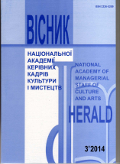ПРИНЦИПИ ВЗАЄМОВПЛИВУ ЕВОЛЮЦІЇ ІНДУСТРІЇ МОД
ТА СУСПІЛЬСТВА СПОЖИВАННЯ
Principles of mutual influeencing of the evolution of fashion industry and consumption society
Author(s): Natalia Vladyslavivna ChuprinaSubject(s): Anthropology, Visual Arts, Sociology of Culture
Published by: Національна академія керівних кадрів культури і мистецтв
Keywords: fashion industry; mass consumption society; fashion standard; fashion trend; fashionable standard; mass-market; fashion clothes;
Summary/Abstract: The thesis grounds that the laws of aesthetic and technology more and more influence the design and promotion of fashion products concerning the quality of mass consumption product, the economic laws, marketing and management in particular, have their more evident impact on them, all this creates a positive environment in the fashion industry for transnational concerns and corporations to strengthen their positions.Analyzing the main historic stages of fashion formation as an industry, it is important to say that the beginning of the XX century, on the one hand, the globalization processes were absent in its development in the world culture and economy, on the other hand, the common fashion tendencies of culture and art development (with insignificant variations) dominated. The development of fashion product manufacturing in mass volume and the world universality of fashion tendencies resulted in informational structure development and total globalization of the world community at the middle of XX century.This is the very period for a split into two separate lines of fashion industry subjects’ activity, which, nevertheless, are developed in a close interaction and supplement one another to satisfy consumer needs for fashion products completely. These lines are typically called "haute couture" and "prêt-a-porte". Characterizing these lines by functional feature, one can admit that these are individual fashion samples designed on a high society demand (in various senses of the term), and fashion clothes of mass production for a mass consumer.In the history of fashion industry development, the 1990s were marked by prevalence of the so-called pluralistic tendencies that leveled the fashion supremacy of one or some correlated actual styles and fashion trends. Besides, engaged in fashion product design, the fashion industry subjects’ growing needs of profits and consumers’ needs in expression of their own ambitions have caused a drastic shortening of fashion product life, a fast integration and spread of fashion innovations due to the mass media sources.The same principles of development, namely, the split of one modern standard into numerous fashion tendencies are observed in many other fields of fashion product market development in this period.By the end of XX century in the fashion industry a term "100 per cent marketing product" came into use, based on cause effect relationship; it means that, as a rule, the over price of a produced fashion sample is explained by a degree of trend mark or designer brand popularity among mass consumers (that more and more depends on aggressiveness of advertising or PR policies of the products) and not by its quality (that decreases rapidly because of the fast moral wear of fashion product).It is impossible to forecast the way the short-term or long-term tendencies of fashion industry development will be and the way they will reflect on fashion creators’ art project activity, the one definite thing is that fashion products, including fashion clothes, accessories, accompanying products and services always bring profit to their producers, conquer new mass sales markets and spheres of consumers’ lives.Moreover, the consolidation of fashion industry subjects remains the major tendency of development, influencing its functioning directly. Large transnational corporations extend the spheres of their influence constantly, forming the fashion industry infrastructure globally this way and facilitating the separation of fashion market segments, and eliminating a competition in fashion business as such.Besides its typical function of promoting fashion products and services onto mass market, at the current stage of development the advertising of the fashion industry has acquired one more important to the fashion process participants function of consumers’ tastes modeling, formation of certain fashion tendencies and stipulating the need in fashion innovations.In other words, fashion products exposed for sale in shops, possessing the high status qualities, acquire a value of cult products in customer’s eyes, meaning a fusion of the mass culture characteristics with mass consumption.The article analyses the fact that the fashion process participants’ behavior is directed not only to mass consumption of fashion industry products, but also to the formation of contemporary art and general culture distinctive features, to a sensitivity to art and aesthetic education of a mass consumer.It follows from this, that a total globalization of society, which becomes stronger every day, contributes not only to culture direct impact on tendencies of contemporary fashion development, creation and spreading of fashion standards, but it also participates in the fashion products design process, universal for different segments of fashion market, regional markets first of all.All the named preconditions (technology, economic and cultures ones) of mass consumption society establishment have led to the fact that high society representatives, who were the only bearers and consumers of modern samples and art innovations before, turned out to be involved in the process of mass consumption because they had to find out and try constantly different fashion innovations to demonstrate their status and social position.On the basis of the mentioned above arguments and facts, the article has outlined characteristics and comparison analysis of principles of fashion clothes industry formation in the context of modern mass consumption society establishment, as well as the definition of the criteria of mutual influence and cause effect basis of evolution of these definitions in the modern society subjects’ consciousness.To sum it up, the thesis concludes that a fashion industry birth and development are closely connected with mass consumption society establishment in the XX century.
Journal: Вісник Національної академії керівних кадрів культури і мистецтв
- Issue Year: 2014
- Issue No: 3
- Page Range: 185-190
- Page Count: 6
- Language: Ukrainian

